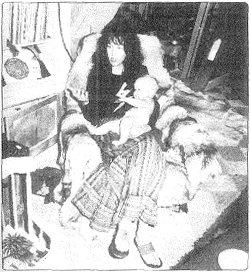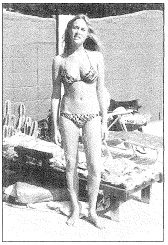
The Chrome Nun
There was yet another reason Paul and I developed respect for the Eastern way of life. We'd seen the movie Enter the Dragon, and both of us were completely taken by the ease of movement and calm self-assurance that Bruce Lee displayed through the use of kung fu. A powerful but graceful form of martial arts, kung fu uses all of the body/mind systems, rather than just the upper-body jabbing of Western boxing. Again, because of adherence to the whole, a Chinese fighter must also learn to heal.
Balance.
The students of White Crane kung fu, the form that Paul and I studied briefly, were taught both the fighting and the healing arts. Yin and yang. Black and white in one circle. Unfortunately, being on the road most of the time made it extremely difficult to maintain the rigorous “workouts” that produce a martial arts adept. The practice has to become a way of life, and I'm afraid I didn't have the discipline to make it a top priority. I think I preferred watching the hard work of physical and mental training rather than actually doing it.
Ron Dong, who was both a friend and a teacher of ours, occasionally came on the road with us to perform an intricate grouping of moves using large swords slicing through the air at lightning speeds. He also attended to everybody's medical needs, taking out his acupuncture needles and “magically” erasing problems that could not be fixed by Western medicine. Acupuncture is now becoming recognized as a formidable medical practice, but when we were going to Master Long's studio in San Francisco in the seventies, Westerners still considered it some goofy offshoot of all the other alternative methods.
Byong Yu, another Eastern master, taught us a martial arts form called tae kwan do, a more direct and leg-focused form of karate. There's a line in one of Paul's songs, “Ride the Tiger,” that synthesizes a conversation we had at dinner one evening, when Mr. Yu was discussing the differences between East and West:
It's like a tear in the hands of a Western man,
He'll tell you about salt, carbon, and water,
But a tear, to an Oriental man,
He'll tell you about sadness and sorrow or the love of a man and a woman
I don't think Byong Yu was accusing all Westerners of being coldhearted chemical engineers, but the heavy emphasis we place on technology in this country clearly bothered him. Of course, Korean and Chinese politics didn't seem to reflect the Asian spiritual ethic. Maybe that's why Master Long, Ron Dong, and Byong Yu were here—they were hoping the best of both cultures would somehow join, allowing each continent to benefit from the union.
Looking back on it, I find it interesting that while many of our contemporaries were studying at the feet of seated Eastern gurus, Paul and I gravitated to a more aggressive physical practice. All forms were headed in the same direction, though. For everyone, the goal was balance.

Sunfighter: China and me in 1971. (AP/Wide World Photos)
In my personal life, the balancing act of being a new mother and making records was made easier by the fact that for the first six months after China was born, we didn't tour. While Paul and I made a “duo” album titled Sun-fighter, which featured fat baby China's picture on the cover, I cared for my daughter during the day and Pat, her nanny, took the nights.
Rolling ocean, small town, new baby, visits with Grandmother, new record, no drugs, and no pressure.
This too shall pass. When I stopped breast-feeding, the liquor crawled slowly back into my bloodstream. Having help both with the baby and the paperwork at the office, I was able to juggle the remainder of my time in the best rock-and-roll tradition. (“Rock-and-roll tradition” could be an oxymoron, but, God knows, there are plenty of traditional morons in rock and roll.) By the time Paul's and my second duo effort, Baron Von Tollbooth and the Chrome Nun, was being recorded, I was back in full swing and displaying a certain sangfroid.
The title of the album was taken from David Crosby's nicknames for the two of us. “Baron Von Tollbooth” was a reference to Paul's facetious pride in his German ancestry, while “the Chrome Nun” evoked my tendency to engage in armored dogma. We constantly proved David's nicknames true, so we mounted no resistance to them.
David had a beautiful “wooden ship” called the Mayan, which he had anchored in a remote, pristine lagoonlike pool of tropical heaven about thirty miles off the Florida coast. After Airplane played Miami, Paul and I took a seaplane out to where David and several of his tanned, blonde, voluptuous nymphs were practicing the art of nautical Shangri-la. The guitars, the plates of fresh food, the marijuana, the nudity—I liked everything about it except that last part. Damned if I was going to be the only dark-haired, flat-chested, skinny white geek to throw myself up for the brutal physical comparison. For the remainder of the visit, the Chrome Nun was the only one wearing clothes—a conspicuous cover-up.
I'm still that way. Ninety-five degrees in L.A., and I'll be the only one not wearing shorts. If you want to let your fifty-year-old cellulite flap around, that's your problem. I find it offensive. I don't want to look at yours and I don't want you looking at mine.
Keep your city beautiful—wear slacks.

Archetypal twentieth-century blonde and, coincidentally, my cowriter, Andrea Cagan. (Juliet Green)
But I must say, I'm getting better at dealing with the blonde mythology that seemed to show up in my life at every turn, and which still does. When I look at a photograph of Andrea Cagan, this book's coauthor, she seems like a composite of every blonde nymph who crossed my consciousness over a period of fifty-eight years. Ironically, these impossible role models with their unattainable beauty have consistently turned out to be among my best and brightest friends.
And sometimes much more than friends.
Leave it to the Cosmic Master Painter to give me a blonde child, who went through puberty without turning brunette like me.
What's a mother to do?